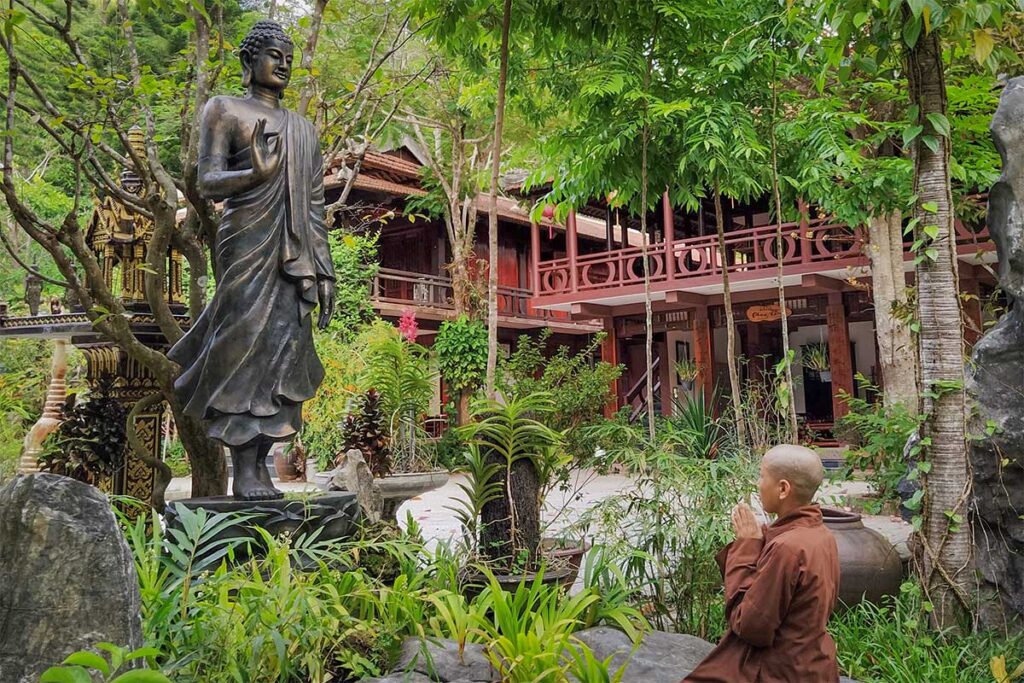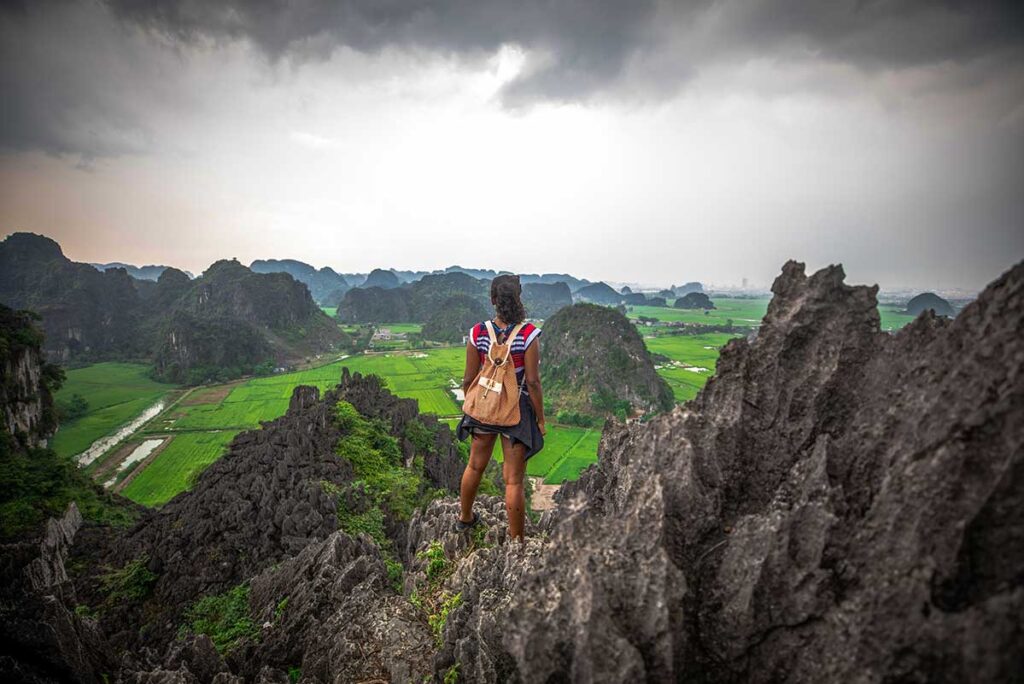What is Huyen Khong Son Thuong Pagoda like?
Location & scenery
Huyen Khong Son Thuong Pagoda is located in Cham Hamlet, Huong Tra District, around a 30-minute drive from Hue city. Tucked deep inside a forested valley, it is surrounded by pine-covered hills that create a mild, refreshing climate throughout the year.

Because it lies off the main tourist routes, the monastery provides a quiet retreat where visitors can immerse themselves in nature and enjoy an atmosphere of calm away from the busier pagodas and imperial landmarks.
History & background
The monastery was founded in 1989 by Venerable Gioi Duc, following the Theravada Buddhist tradition. Unlike many other pagodas in Vietnam, it was designed without the iconic Tam Quan triple gate. Instead, the architecture takes inspiration from Hue’s traditional wooden “ruong houses,” blending seamlessly with the natural surroundings. Its purpose was never to impress with grandeur but to cultivate an environment for meditation, reflection, poetry, and calligraphy—values that remain central to the monastery today.
Daily use today

Huyen Khong Son Thuong remains an active monastic community with a small number of monks and nuns who live, study, and practice meditation here.
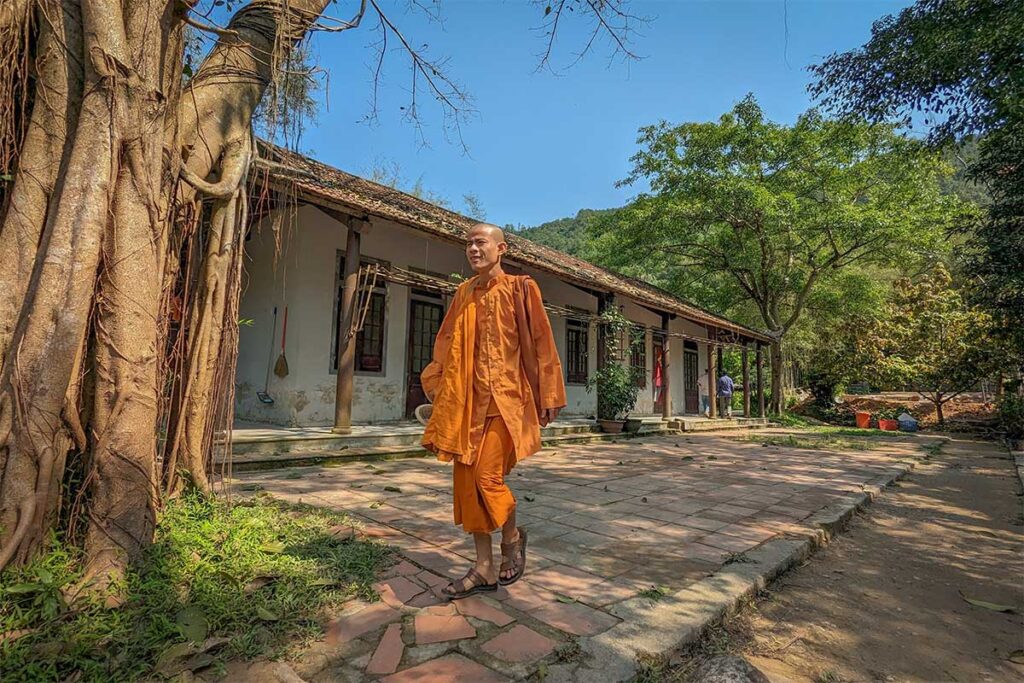
Public areas of the monastery are open for visitors, while certain sections are reserved for the resident community. The monastery is also well-known for its integration of art and spirituality, with calligraphy, poetry, and carefully designed gardens reinforcing its contemplative and aesthetic character.
Highlights of visiting Huyen Khong Son Thuong
1. The entrance & garden setting
Unlike many other pagodas in Vietnam, Huyen Khong Son Thuong does not have a grand triple gate. Instead, visitors enter through a modest wooden gateway, more reminiscent of a traditional Hue home. Beyond the entrance lies a carefully landscaped garden with lily ponds, orchids, and century-old trees, creating a serene first impression that sets the tone for the visit.
2. The main hall (Chánh Đien)


The main hall is modeled after Hue’s traditional wooden “ruong house” architecture, with its simplicity emphasizing natural materials rather than ornate decoration.

Inside, worship is dedicated to Buddha Shakyamuni alongside relics of the Buddha and revered monks. The understated design allows the quiet atmosphere and the fragrance of wood to enhance the sense of meditation and stillness.
3. Am May Tia (Purple Cloud Hut)
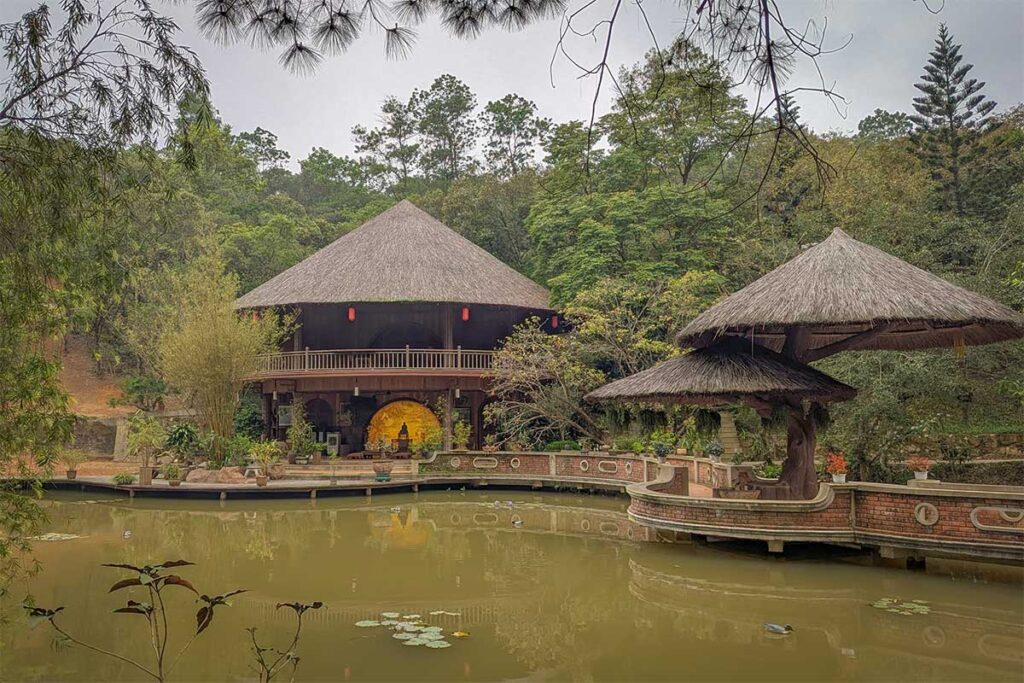
Am May Tia, or the Purple Cloud Hut, is both the abbot’s residence and a space for meeting guests. More than just living quarters, it has become a hub for calligraphy, poetry, and thoughtful discussion. Those with an interest in literature or Buddhist philosophy may find this space particularly inspiring.
4. Nghinh Luong Đình (Rest Pavilion)

This open-sided pavilion is a resting spot where visitors and monks alike pause for tea and conversation. Surrounded by ancient frangipani and orchid trees, it offers a shaded, breezy space that feels like an extension of the gardens themselves. It’s one of the best places to slow down and appreciate the peaceful rhythm of monastic life.
5. Calligraphy & art spaces
Art plays a central role at Huyen Khong Son Thuong. The monastery features a stone-and-grass garden and a dedicated calligraphy pavilion where verses often change with the seasons. Poetry, inscriptions, and calligraphy can be found throughout the grounds, blending artistic expression with the natural setting in a way that feels uniquely Hue.
6. Meditation forest & hidden corners
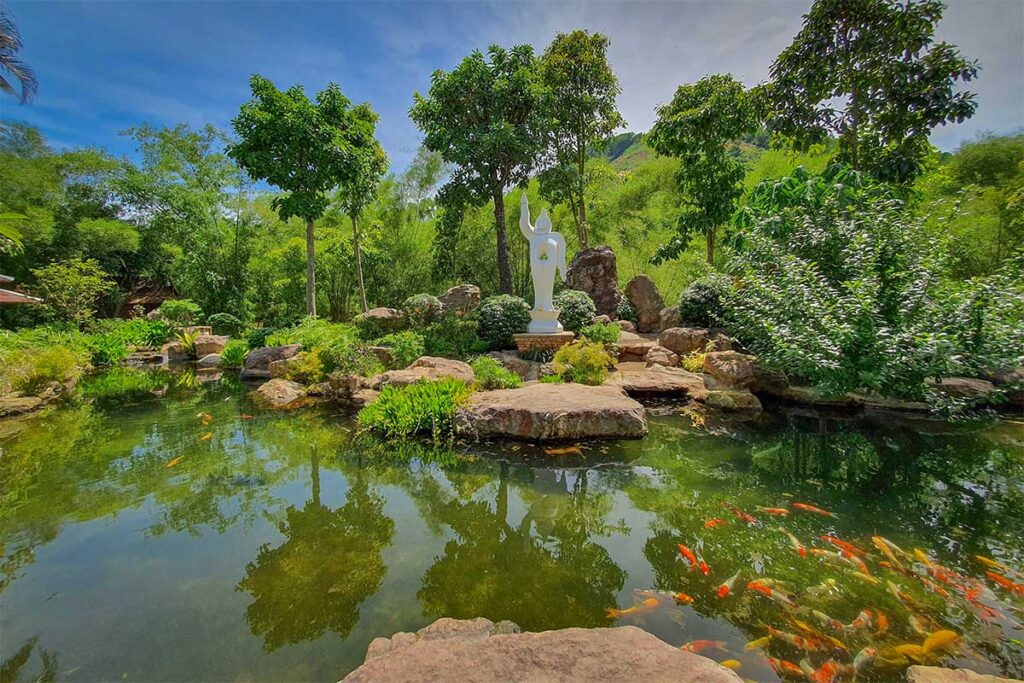
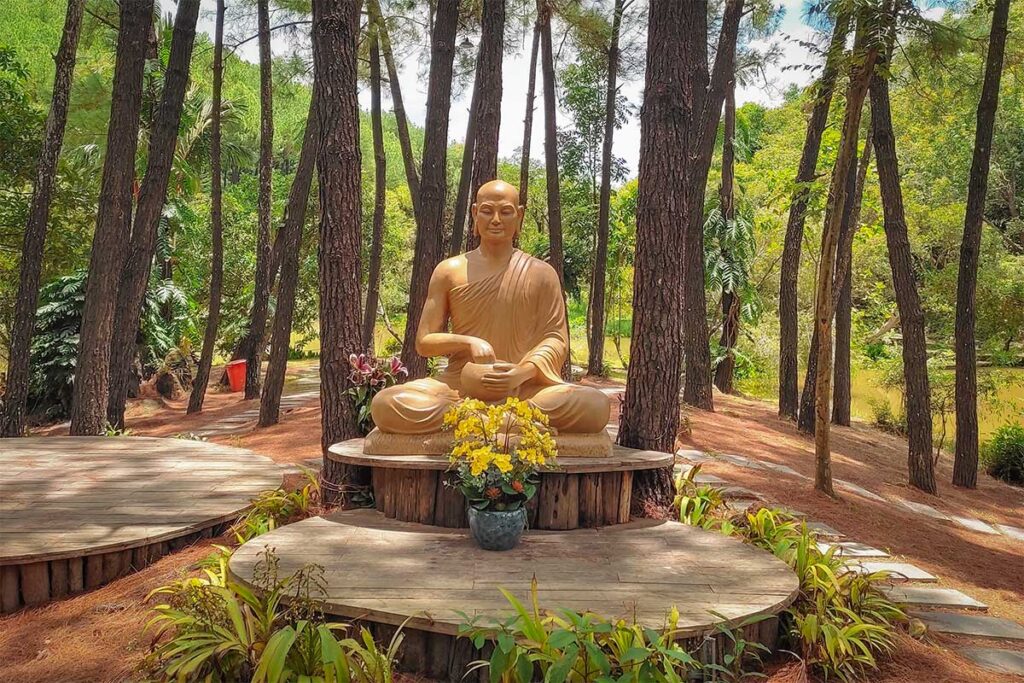
Beyond the main buildings, walking paths lead into a surrounding pine forest. Here, visitors can find secluded corners for quiet reflection, wooden signs inscribed with thoughtful sayings, and the occasional sculpture or hidden shrine. It is a part of the monastery best experienced slowly, letting the forest calm the senses.
7. Views & small details
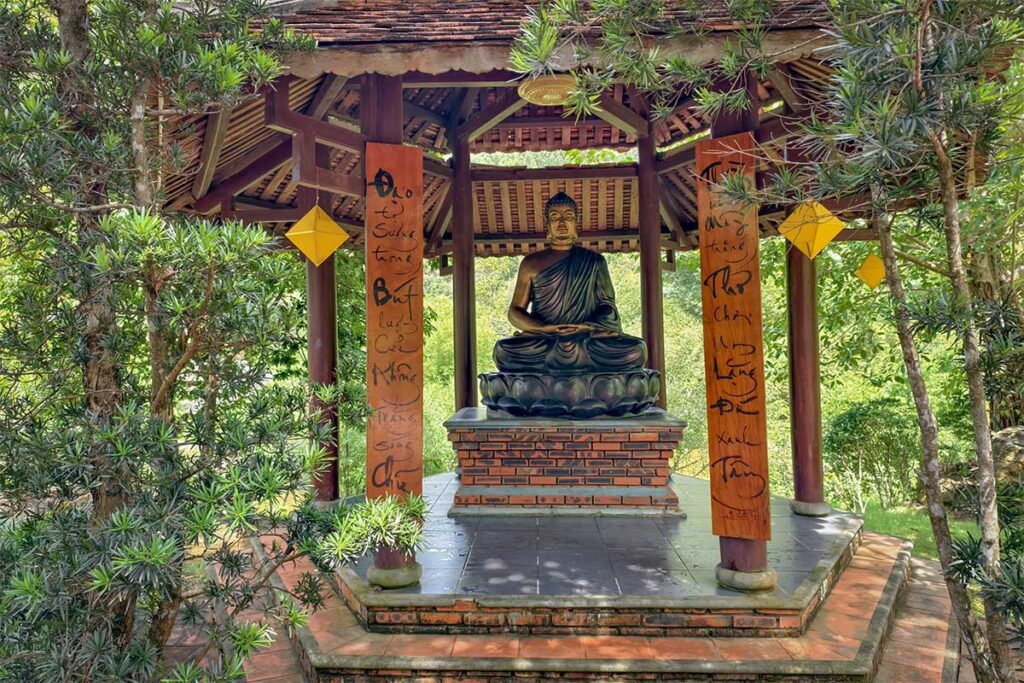
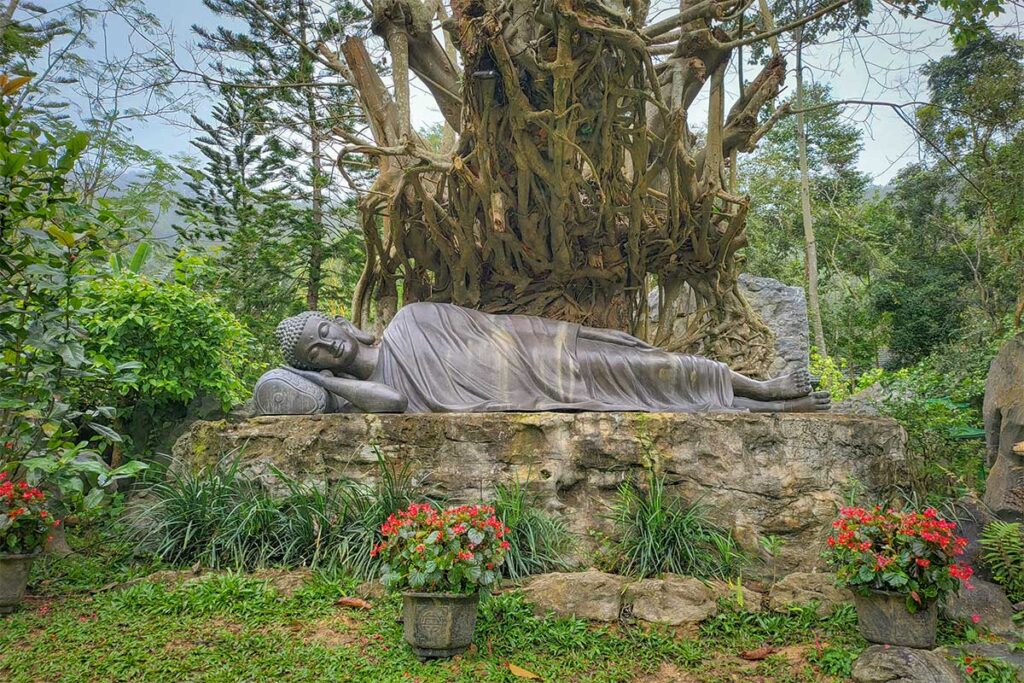
Exploring the grounds often reveals subtle details: a reclining Buddha tucked away, wooden bridges crossing ponds, or stone inscriptions with poetic messages. These smaller touches reward those who take their time, making each visit a personal journey of discovery.
Nearby attractions: Khe Ngang Lake & Hon Vuon Peak
Just a short distance from Huyen Khong Son Thuong Pagoda are two natural spots that can easily be combined with a visit to the monastery.
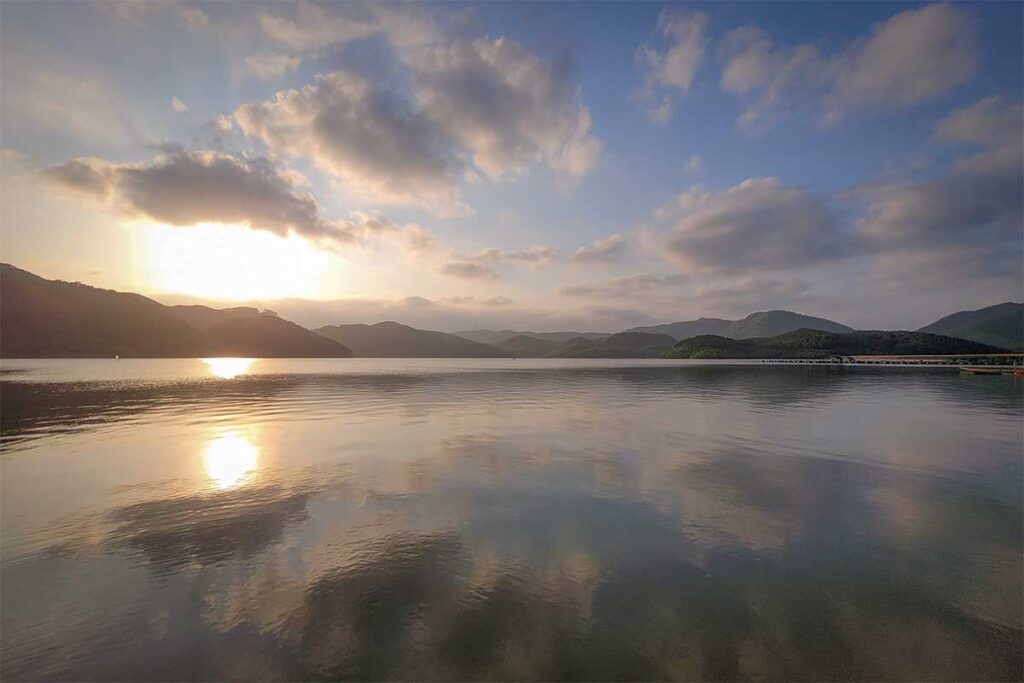
Khe Ngang Lake is a quiet reservoir surrounded by forested hills. While it may not stand out as one of Hue’s major highlights, it offers a peaceful stop where you can enjoy the fresh air, calm waters, and simple scenery. It works well as a short detour to round out your trip.
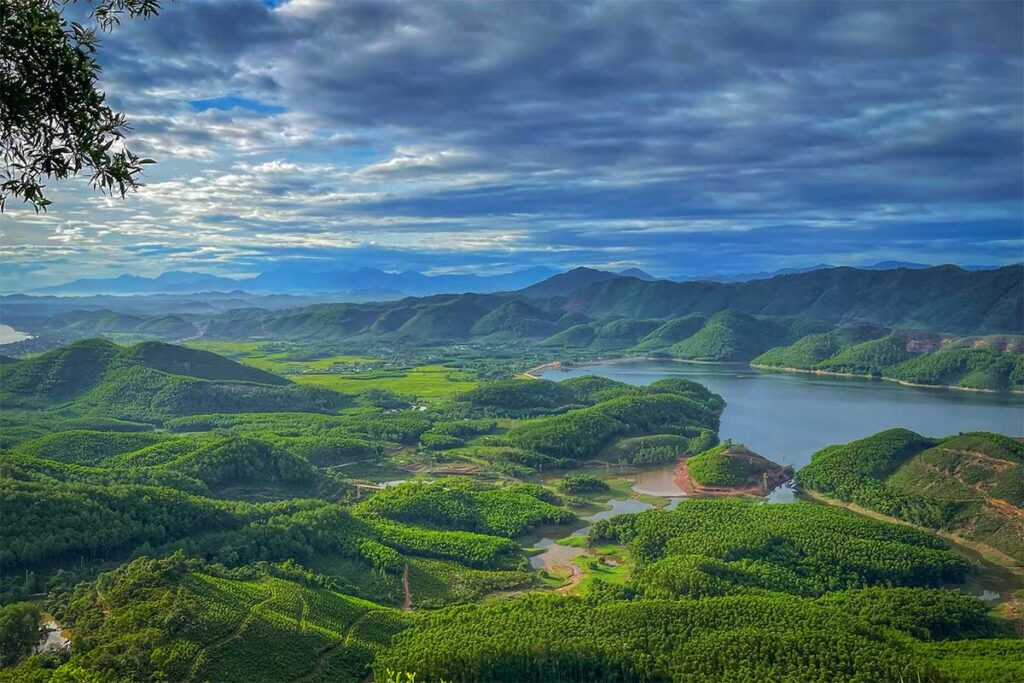
For something more active, Hon Vuon Peak provides a trekking option with rewarding views over the lake and the surrounding valleys blanketed in pine and forest. The climb is not long but adds a sense of adventure, and from the top you can take in a panoramic landscape that contrasts nicely with the monastery’s enclosed gardens.
Together, the monastery, lake, and peak make a balanced half-day itinerary that combines culture, nature, and light outdoor activity.
How to get here
Where is the monastery?
Huyen Khong Son Thuong Pagoda is located about 12–15 km northwest of Hue city center, in Cham Hamlet, Huong Tra District. The final stretch leads down a narrow rural road through rice fields and forested hills, giving the approach a quiet and secluded feel. Its remote setting is part of the charm but also means you should plan your transport carefully.
Getting there
- Taxi: A straightforward option, but make sure to arrange for the driver to wait. The area is remote, and it is unlikely you will find a return taxi.
- Car with driver: The most convenient choice, especially if you want to combine the monastery with other stops like Khe Ngang Lake or a royal tomb. A driver will wait while you visit, offering flexibility and peace of mind.
- Motorbike rental: Ideal for independent travelers looking for flexibility and low cost. The roads have light traffic, but parts can be bumpy and narrow, so some experience riding in rural Vietnam helps.
Tip: Add Thien Mu Pagoda
Thien Mu Pagoda, one of Hue’s most famous landmarks, is located along the route from the city toward Huyen Khong Son Thuong. Combining the two makes for a convenient half-day trip, giving you both a major cultural highlight and a peaceful off-the-beaten-path experience.
Practical visiting information & tips
Opening hours & fees
There are no official opening hours, but it is best to visit during daylight. Entry is free, and while donations are welcome, they are not expected.
Dress code & etiquette
As with any religious site in Vietnam, dress modestly by covering shoulders and knees. Shoes should be removed before entering prayer halls. Keep voices low and remain respectful, especially in areas where monks and nuns may be meditating.
Facilities
The monastery has basic toilet facilities, though they can be a bit hidden within the grounds. Parking is available at the entrance for a small fee (around 5,000 VND for scooters and 10,000 VND for cars). The site is not particularly suitable for visitors with mobility issues, as paths are uneven and steps are common.
Best times to visit
The morning hours are the most tranquil, with soft light and cooler air. On Vietnamese holidays and festivals, the monastery can attract more visitors than usual, though it rarely feels crowded compared to central Hue pagodas. For the quietest experience, weekdays outside of peak holiday periods are ideal.
Is Huyen Khong Son Thuong Monastery worth visiting?
Huyen Khong Son Thuong Monastery is a rewarding stop if you are looking for peace, nature, and a place to step away from the more crowded temples of Hue. Its gardens, meditation halls, and forested setting make it ideal for travelers interested in calm reflection or simply enjoying a less-touristy side of the city.
However, if your time in Hue is limited and your priority is to see the imperial landmarks and royal tombs that the city is famous for, you won’t miss anything essential by skipping it. The monastery is best suited for those with a half day to spare who want an offbeat mix of culture and nature.
